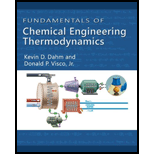
A)
Interpretation:
Prove that the heat capacity of this gas is independent of pressure.
Concept introduction:
Write the relationship between
Here, change in constant pressure heat capacity with respect to change in pressure at constant temperature is
Express the equation of state as given as follows:
Here, gas constant is R, temperature and pressure is T and P, constant is a, and molar volume is
B)
Interpretation:
the expression for
Concept introduction:
Write the fundamental relationship for molar internal energy.
Here, change in molar internal energy is
Use the expansion rule for
Here, change in molar entropy with respect to change in pressure at constant temperature is
C)
Interpretation:
Concept introduction:
Write the total derivative of
Here, change in molar internal energy with respect to change in temperature at constant pressure is
D)
Interpretation:
the molar change in entropy has to be determined.
Concept introduction:
The change in molar entropy for real gas model is given as follows:
Here, residual molar entropy of inlet and exit state is
Trending nowThis is a popular solution!

Chapter 6 Solutions
Fundamentals of Chemical Engineering Thermodynamics (MindTap Course List)
 Introduction to Chemical Engineering Thermodynami...Chemical EngineeringISBN:9781259696527Author:J.M. Smith Termodinamica en ingenieria quimica, Hendrick C Van Ness, Michael Abbott, Mark SwihartPublisher:McGraw-Hill Education
Introduction to Chemical Engineering Thermodynami...Chemical EngineeringISBN:9781259696527Author:J.M. Smith Termodinamica en ingenieria quimica, Hendrick C Van Ness, Michael Abbott, Mark SwihartPublisher:McGraw-Hill Education Elementary Principles of Chemical Processes, Bind...Chemical EngineeringISBN:9781118431221Author:Richard M. Felder, Ronald W. Rousseau, Lisa G. BullardPublisher:WILEY
Elementary Principles of Chemical Processes, Bind...Chemical EngineeringISBN:9781118431221Author:Richard M. Felder, Ronald W. Rousseau, Lisa G. BullardPublisher:WILEY Elements of Chemical Reaction Engineering (5th Ed...Chemical EngineeringISBN:9780133887518Author:H. Scott FoglerPublisher:Prentice Hall
Elements of Chemical Reaction Engineering (5th Ed...Chemical EngineeringISBN:9780133887518Author:H. Scott FoglerPublisher:Prentice Hall
 Industrial Plastics: Theory and ApplicationsChemical EngineeringISBN:9781285061238Author:Lokensgard, ErikPublisher:Delmar Cengage Learning
Industrial Plastics: Theory and ApplicationsChemical EngineeringISBN:9781285061238Author:Lokensgard, ErikPublisher:Delmar Cengage Learning Unit Operations of Chemical EngineeringChemical EngineeringISBN:9780072848236Author:Warren McCabe, Julian C. Smith, Peter HarriottPublisher:McGraw-Hill Companies, The
Unit Operations of Chemical EngineeringChemical EngineeringISBN:9780072848236Author:Warren McCabe, Julian C. Smith, Peter HarriottPublisher:McGraw-Hill Companies, The





